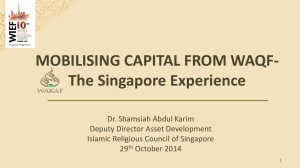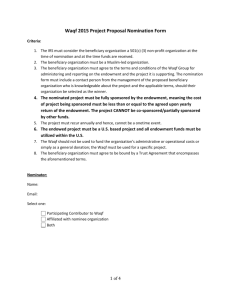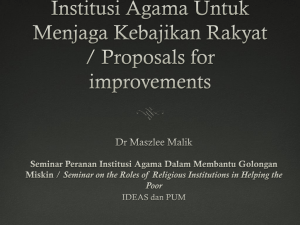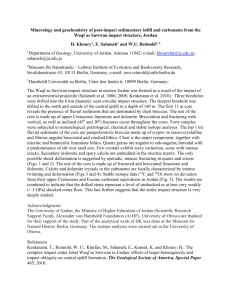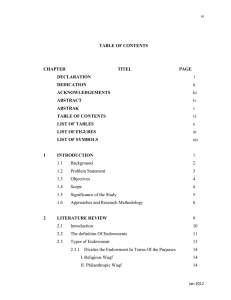Istibdal - Macrotheme
advertisement
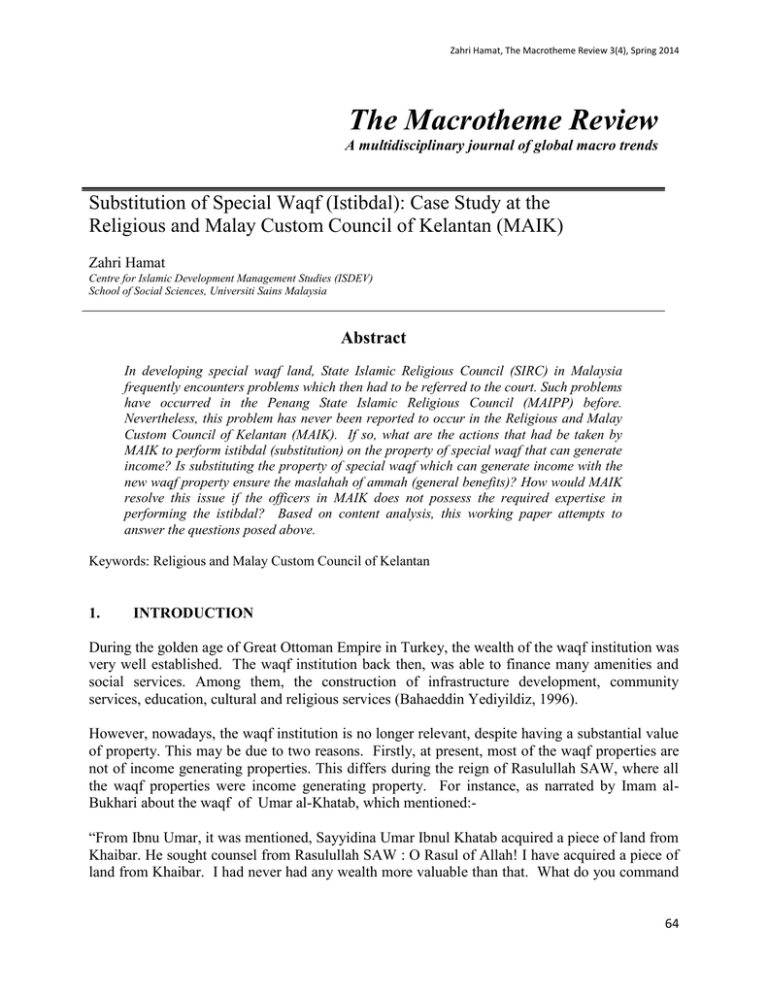
Zahri Hamat, The Macrotheme Review 3(4), Spring 2014 The Macrotheme Review A multidisciplinary journal of global macro trends Substitution of Special Waqf (Istibdal): Case Study at the Religious and Malay Custom Council of Kelantan (MAIK) Zahri Hamat Centre for Islamic Development Management Studies (ISDEV) School of Social Sciences, Universiti Sains Malaysia Abstract In developing special waqf land, State Islamic Religious Council (SIRC) in Malaysia frequently encounters problems which then had to be referred to the court. Such problems have occurred in the Penang State Islamic Religious Council (MAIPP) before. Nevertheless, this problem has never been reported to occur in the Religious and Malay Custom Council of Kelantan (MAIK). If so, what are the actions that had be taken by MAIK to perform istibdal (substitution) on the property of special waqf that can generate income? Is substituting the property of special waqf which can generate income with the new waqf property ensure the maslahah of ammah (general benefits)? How would MAIK resolve this issue if the officers in MAIK does not possess the required expertise in performing the istibdal? Based on content analysis, this working paper attempts to answer the questions posed above. Keywords: Religious and Malay Custom Council of Kelantan 1. INTRODUCTION During the golden age of Great Ottoman Empire in Turkey, the wealth of the waqf institution was very well established. The waqf institution back then, was able to finance many amenities and social services. Among them, the construction of infrastructure development, community services, education, cultural and religious services (Bahaeddin Yediyildiz, 1996). However, nowadays, the waqf institution is no longer relevant, despite having a substantial value of property. This may be due to two reasons. Firstly, at present, most of the waqf properties are not of income generating properties. This differs during the reign of Rasulullah SAW, where all the waqf properties were income generating property. For instance, as narrated by Imam alBukhari about the waqf of Umar al-Khatab, which mentioned:“From Ibnu Umar, it was mentioned, Sayyidina Umar Ibnul Khatab acquired a piece of land from Khaibar. He sought counsel from Rasulullah SAW : O Rasul of Allah! I have acquired a piece of land from Khaibar. I had never had any wealth more valuable than that. What do you command 64 Zahri Hamat, The Macrotheme Review 3(4), Spring 2014 me to do with it? Rasul of Allah replied: If you wish, make waqf it’s origin (from Allah SWT) give as sadaqah it’s income” (al-Bukhari, Hadith: 938). Secondly, waqf institution operates with limited human resources, not to mention lack of expertise in some field such as technical and financial. The impact of lack of financial expertise is that, the income earned by waqf institution will be very low. For instance, in Egypt, the value of waqf properties reach half trillion Egyptian pounds; but the annual income received is only estimated at 1.5 billion pounds. This problem occurs due to lack of expertise particularly in the area of finance (al Arabiya News, on-line 24th July 2012). This lack of expertise is a common challenge faced by other Muslim countries including some states in Malaysia. To develop waqf property, particularly through istibdal, expertise is an important factor. It involves expertise in both financial and technical fields. The question is, to materialize istibdal, do the officers from Religious and Malay Custom Council of Kelantan (MAIK) have both of these expertise? If MAIK officers do not possess the required expertise, how can these issues be solved? Besides, in terms of maslahah amah (common good), how can istibdal benefit MAIK, particularly on acquiring new property which can generate income instead of replacing the newly acquired property with the same waqf property? Thus, this paper will be divided into three sections. Firstly, this paper will analyse the background of istibdal, particularly about the method and its application in Malaysia. Second, this paper will explain the development of waqf property at Lot 146, Sek.12, Kota Bharu through istibdal by MAIK. The last section will review several approaches that can be taken to overcome the lack of technical and financial expertise. 2. ISTIBDAL AND ITS APPLICATION IN MALAYSIA Waqf property is any property that is held by the waqif’s heir from any sales and purchases, inheritance, grant and a will. Benefit of the waqf property in terms of income, acquisition or other benefits will be determined by the waqif itself (JAWHAR, 2010). Any waqf property that do not provide any benefits will be allowed to be substituted by the process of istibdal with better property in terms of economy benefits as long as it is still in maslahah for people. Istibdal can be defined by buying any other new property with sales revenue that will be used as mawquf to replace the old property under substitution method with the same values or with better benefits (JAWHAR, 2010). Ulama have different opinions on how to implement istibdal. Madhhab Hanafi approved the use of Istibdal except for waqf mosque1. Madhhab Shafi’e however, stated that the application of istibdal is limited, particularly in prohibition of istibdal on waqf mosque2. Several Ulama from Madhhab Maliki allowed the use of istibdal on immovable property which does not provide ³The use of istibdal only involves waqf property other than the mosque. The application of istibdal on waqf mosque is not applicable in any circumstances either being sold or replaced with any other land/property (Wahbah al-Zuhaili, 1989). ⁴However, istibdal can be implemented on waqf mosque if the mosque is damaged and collapsed. New mosque must be built as a replacement and must be near the collapsed waqf mosque. Apart from mosque, istibdal can be implemented by selling or replacing the property (Wahbah al-Zuhaili, 1989). 65 Zahri Hamat, The Macrotheme Review 3(4), Spring 2014 benefits to recipients or waqf trustee and the property required to be exchanged for the same type of property3. However, according to ulama from Madhhab Hanbali, istibdal is openly applied compared to other Madhhab . In fact, istibdal involving mosques is also permissible if the waqf of the mosque does not meet the purposes of waqf such as limited area within the mosque’s compound to accommodate more people and unable to expand the area, or the mosque is no longer in use by people or caused by collapsed and damaged (Wahbah al-Zuhaili, 1989). This is due to istibdal which is undertaken by Umar al-Khattab on the mosque in Kufah. The mosque was still used by the people of Kufah but was transformed as a market for the locals (Ibn Taimiyyah, 1991). Application on istibdal among Madhhab Hanbali can be divided into two conditions, first, istibdal can be done because of needs; and two, istibdal can be done because of the requirement of maslahah. In Malaysia, in certain circumstances, State Islamic Religious Council should implement istibdal (JAWHAR, 2010)4. Istibdal is permissible in terms of laws or fatwas. In terms of laws, three states had included specific provision about istibdal in their state enactment. The laws include Waqf Enactment (State Selangor) 1999 (No. 7 Year 1999), Waqf Enactment (Negeri Sembilan) 2005 (No. 5 Year 2005) and Waqf Enactment (State Malacca) 2005 (No. 5 Year 2005). For states that had not included statutory provisions, the authority to implement the istibdal is with Islamic Religious Administration under subsidiary laws of the state (JAWHAR, 2010)5. Furthermore, there was also istibdal provision which was made under State Subsidiary Laws such as Johor, under Kaedah-kaedah Waqf 1983 (JPU.51/85). Same interpretation can be found in Waqf Enactment (Negeri Sembilan) 2005 and Waqf Enactment (Malacca) 20056. In terms of fatwas, istibdal was decided both by National Fatwa Council and State Fatwa Council. On 13th April 1982, muzakarah by National Fatwas Council, 4th Islamic Affairs decided that a replacement waqf is to change the mawquf with other property by way of sales or purchases with the purpose to maintain the mawquf , is permissible according to taqlid from Imam Abu Hanifah. In muzakarah by National Fatwas Council, 41st Islamic Affairs which was held on 3rd⁵Imam Maliki himself stated, istibdal application on immovable property is not applicable completely otherwise there are maslahah needs for the istibdal to be implemented or for the benefits of the ummah such as expanding the mosque compound, the cemetery, public road and etc, or the mawquf is taken by force by authorities or nazir (Wahbah al-Zuhaili, 1989). ⁶Condition such as, first, limited area of the waqf property dan difficult to develop; second, unused waqf property dan unable to develop for benefits of Muslim; third, the position and location of the waqf property is far, scattered and not suitable to be developed; fourth, the outcome and benefits do not reach the waqif’s objectives and purposes; fifth, the usage of waqf property did not provide benefits anymore; sixth, waqf property which involves in reinstatement from any authorities via Act of Land Reinstatement 1960; and seventh, waqf property that involves in handover to state authorities intended for changes in rights/express terms/status of property usage such as road or open-space land. ⁷Section 2(1) Waqf Enactment (Selangor) 1999 allocates the interpretation of istibdal as follows: “…replacing one waqf property with another property or same value of money or higher either via replacement, purchases and sales or any other methods based on Islamic laws”. ⁸Meanwhile, under Kaedah 2, Kaedah-kaedah Waqf Johor 1983, istibdal was interpreted as: “…replacing the waqf property with another improved property by exchange, purchases and sales or any other appropriate methods based on Islamic laws” 66 Zahri Hamat, The Macrotheme Review 3(4), Spring 2014 4th November 1996, it was decided that istibdal is a good act and should be practiced, in view of rapid development throughout the country, while waqf properties, such as unattended and abandoned mosque site may caused problems to the authorities. States in Malaysia also agreed with the fatwas decided by National Fatwas Council7. In terms of implementation, istibdal is already applied in Federal Territory of Kuala Lumpur, Penang, Malacca, Perak, Terengganu and Kelantan (JAWHAR, 2010)8. Istibdal occurs in two forms9. First, change or replace the property with the same value of new property. For example, the istibdal on special waqf property at Lebuh Teik Soon (land) Maahad al-Manshoor al-Islami which was taken by the Islamic Religious Council of the Pulau Pinang State (MAINPP) and was replaced with property (land) at Mukim Genting, Balik Pulau for development of a new Maahad al-Mashoor al-Islami. Perak Islamic Religious Council (MAIAMP) has implemented istibdal on Lot 3758 (land), Kg. Kacu, Tapah after the property has been acquired by state authorities due to public interests. Compensation from the state land acquired was used by MAIAMP to buy new plots of land to replace the land which has been acquired by the state authorities. Malacca Islamic Religious Council (MAIM) also applied istibdal at Tanah Merah Mosque site, Pantai Kundur, Malacca after the state authorities acquired the land. The mosque was demolished and was replaced with a new Pantai Kundur Mosque at a different location. Secondly, buying new waqf property from the land acquisition’s compensation. The potential property or land was purchased notwithstanding it was owned by individual, communities or organization. Federal Territory of Kuala Lumpur Islamic Religious Council implemented three istibdal which involved three different locations; first, Lot 168, Jalan Perak; second, Lot 169, Jalan Perak and; third, Lot. 107, Jalan Raja Muda. In addition, Malacca Islamic Religious Council has also implemented istibdal on a land and on a 3 storey shop house situated at Lot 233, Kawasan Bandar 20, Jalan Bendahara, Off Jalan Temenggung. Proceeds from the sales were used to buy a land and a building at Lot 8166 and 8167, Taman Tasik Utama, Air Keroh. 3. DEVELOPMENT BY ISTIBDAL AT LOT 146, SEK. 12, KOTA BHARU, KELANTAN Waqf management in MAIK is placed under the Baitumal Unit. This unit is headed by a Chief Development Officer who is responsible in developing waqf property including other MAIK’s properties. An example of waqf property that will be developed is the collaborative project ⁹For Federal Territory of Kuala Lumpur, Jawatankuasa Perundingan Hukum Syarak in a 35 th meeting on 19 November 1993 has agreed to use istibdal on waqf property by moving the property from a place to another place which is beneficial but must acquire the same or better value of a new waqf property. State Mufti of Malacca on the behalf of Malacca Syariah Council has issued a fatwa, which means if any waqf property was taken aback by state authorities; the compensation must be paid to State Islamic Religious Council in order to replace the old waqf property with a new waqf property. ¹⁰For several states whose still not implement the istibdal, it is said that there is no problem arise regarding on waqf property yet (JAWHAR, 2010). ¹¹There are some cases involving istibdal in both types. Implementation of istibdal by Kedah Islamic Religious Council (MAIK) on dual-runway electric train from Ipoh to Padang Besar which involves the transfer of Muslim cemetery; and a structure in mosque compound that needs to be demolished and replaced. The decision by State Fatwa Council is istibdal for those cases by replacing the land with another new land property and paid the compensation of current value to Malacca Islamic Religious Council. 67 Zahri Hamat, The Macrotheme Review 3(4), Spring 2014 between MAIK and Menang Intan Sdn. Bhd. at Lot 145, Sek. 4, Kota Bharu. The collaboration includes a development of 30 units of three-storey shop houses, 19 units of terrace houses, 4 units of semi-detached houses and 1 unit of bungalow. Apart from joint development, the waqf land development by istibdal was also agreed to by MAIK’s Ulama. They released a fatwa on the development by istibdal on 5th August 1995 which stated that any mawquf substitution or sales can be performed on waqf land in necessary situation and benefits the ummah including property or mawquf that have insufficient proceeds to cover the maintenance cost. This decision was based on opinion from Ibn Taimiyyah and writings by Dr. Abd Salam Madkur. The implementation of istibdal at Lot. 146, Sek. 12, Kota Bharu started when Permodalan Nasional Berhad (PNB) took over the administration of Hotel Perdana Kota Bharu10. PNB had discovered there was an abandoned Muslim cemetery site next to the hotel building and the land was needed by PNB for expansion purposes. Following this, PNB sent formal application to MAIK in 1998 and MAIK responded to the application by declaring the land could be owned by PNB based on current valuation. Valuation and Property Services Department had evaluated the land with the valuation of RM 2,650,000.00. Permodalan Nasional Berhad (PNB) has requested for revaluation of the land with reasons as stated below: i. Permodalan Nasional Berhad (PNB) is a subsidiary owned by Yayasan Pelaburan Bumiputera (YPB) which is responsible to promote and monitor investments as well as to increase Bumiputera Corporate Sector equity. ii. PNB intends to develop the property in hospitality industry in that area and will indirectly assist to boost the Kelantan’s economy MAIK has declined the request by PNB. However, PNB subsequently agreed with the valuation of RM 2,650,000.00 by Valuation and Property Services Department. MAIK then referred the matter to the Sultan Kelantan Office, and the Sultan gave consent on the matter on 3rd December 2008. The Sultan also decreed that the proposed development of the abandoned Muslim cemetery site to be consulted with Mufti of Kelantan. Mufti then gave his views on 22nd December 2008 about the proposal of redeveloping new Muslim cemetery at Lot, 146, Sek. 12, Kota Bharu as below: i. The old cemetery which was no longer used to bury the dead and it was believed that the remains of the corpse has become soiled, then the grave must be excavated and transferred to a new graveyard. ii. Permissibility based on public interests and it is government-owned reserved area. 10 Istibdal data about Lot 146, Sek. 12, Kota Bharu was acquired based on interview with Ridhwan Abdul Rahman, Baitumal and Waqf Officer, MAIK on 24th July 2012, at 9.30 a.m - 12.30 p.m. 68 Zahri Hamat, The Macrotheme Review 3(4), Spring 2014 iii. MAIK as a sole controller and nazir to all waqf property must use the compensation received from PNB for burial related matters such as buying a replacement cemetery land and fulfilled the terms of exchange. Based on the responses received by Mufti Department, MAIK offered for sale of the land to PNB with the valued price of RM 2,650,000.00 and the cost of excavating the old graveyards shall be financed entirely by PNB. Implementation of istibdal on the land can be explained below: i. Lot 146 Section 12, Kota Bharu was a waqf irsyad grave and has not been used for a long time. ii. The use of this land as waqf grave was no longer suitable because it is located in an area that is rapidly developing. iii. PNB as the applicant of the land is an entity set-up by the government to protect the interests of the Bumiputera and Muslims. Development of this land would benefit the maslahah of Muslims in Kelantan, socially and economically. MAIK already received the compensation by PNB. The money was deposited in a special account to purchase a replacement land for the graveyard. MAIK is trying to find a suitable land for the development of the new graveyard. This istibdal money can actually be used for the development of new graveyard or to improve the existing graveyard available. 4. MAIK’S APPROACH IN TECHNICAL AND FINANCIAL FIELD Other than finding substitution land for new graveyard, this istibdal method raised two issues; first, was the valuation done by Valuation and Property Services Department justified and in accordance with the current valuation? To justify, during the valuation process, factors that influenced the price of the land need to be considered. Secondly, what kind of other property that should be substituted so that it provides maximum benefits to MAIK, apart from the graveyard as replacement to the original waqf? In the evaluation process on Lot 146, Section 2, Kota Bharu, Valuation and Property Services Department imposed ‘highest and best use’ consideration with the assumptions as follows: i. The use (hotel) is allowed by the planners; ii. The use is based on current demand, which is a trade, and; iii. Free from vacant possession, where the cost of excavating the graveyard borne by the landlord. After taking into consideration the factors that influenced the above valuation, the valuation officers have considered the fair market value is at RM 2,400,000.00. It was proposed that for the purpose of disposing of the property for development, the negotiation started from RM 2,650,000.00. Although the valuation of the land was to consider the three factors above, was the valuation reasonable? In this case, there is no valuation comparison being done with other parties. This is important because there was a court rule on the appreciation value, according to Part 2 (b), First Schedule of Land Acquisition Act 1960. For instance, Estate and Trust Agencies (1972), Limited 69 Zahri Hamat, The Macrotheme Review 3(4), Spring 2014 vs The Collector of Land Revenue, Johor Bharu, High Court, Johor Bharu. The issue was, what is the fair market value of the land acquired on 21.11.1954? And what, if any, increase in value of the plaintiff’s adjoining land was likely to accrue from the use of the acquired land as a school. The Court ruled as follows: i. The Court adopted the Residual Method used by the respondent’s value but made some changes to the values. The award was approximately 25.5 cents per sq. ft. for the overall land acquired of 12 acres 0 rood 16 poles, and deducting betterment value from the applicant’s adjoining land. ii. The Court allowed for betterment but considered 5% increase to be reasonable. However, in this istibdal case, the Valuation and Property Services Department appreciated the value of the land to RM 2,650,000.00 which is an increase of 10% from RM 2,400,000.00. To determine the potential value of the land is difficult. Judge Abdul Razak on 4th March 1990 in a case of Mohd Salleh bin Agil, Ismail bin Sidek, Yaacob bin Hassan vs Johor Bharu Tax Collector, The High Court gave the following comments:“…to have potential for a mature use, it depends on its needed (demand) for such use, if not, even though the potential is there, but the time has not come to be used. If not we can say a place in the wilderness has the potential to set up a town, for example, although it is far from human habitation. The potential may be there, but in a period very far ahead. Provide a price to land the potential that seems at this time, it would not be reasonable”. MAIK also experienced problem for a better substitution property at a reasonable price. Therefore, the inaugural seminar organized by Department of Awqaf, Zakat and Hajj (JAWHAR) in collaboration with Directors of Lands and Mines Office (JKPTG), namely Seminar Transformasi Peletakhakan Tanah Wakaf was held on 25th until 27th April 2012 at Permaisuri Resort, Port Dickson, Negeri Sembilan focused on the current problems. This seminar successfully attracted a total of 153 participants from the State Islamic Religious Council (MAIN) the sole trustee of waqf property, Lands and Mines Office (PTG), Districts and Lands Office (PTD), Putrajaya Directors of Lands and Mines Office (JKPTG Putrajaya), States Directors of Lands and Mines Office, Awqaf Malaysia Foundation (YWM) and Public Universities (IPTA)11. Among the important resolutions agreed from the seminars are: i. A comprehensive and integrated master plan for development of waqf will be drafted by JAWHAR in collaboration with related parties as a reference and guide to all stakeholders to strengthen the development of waqf land. 11 Eight papers were presented by presenters who were experts in waqf property management; namely Datuk Haji Anan C. Mohd, Director General of JAWHAR, Dato’ Sri Wan Haji Abdul Wahid bin Haji Wan Hassan, Deputy President Majlis Ugama Islam dan Adat Resam Melayu Pahang (MUIP), Tuan Haji Mahammed Naser Desa, Senior Attorney Jabatan Peguam Negara, Tuan Haji Kamil Mohamed, Director Sistem Pendaftaran Tanah Berkomputer JKPTG, Tuan Haji Ab. Aziz bin Ismail, Deputy Director Pasukan Rintis e-Tanah, Tuan Haji Wan Halim bin Wan Harun, Consultant Pesaka Kecil dan senior officers of State Islamic Religious Council (MAIN). Many aspects have been highlighted to the participants in 3 days/2 nights seminar, for example; legislation, development, registration, ICT system, small inheritance and experience sharing among MAIN from 3 states; Selangor, Pulau Pinang and Johor. 70 Zahri Hamat, The Macrotheme Review 3(4), Spring 2014 ii. Strategic alliances continue to be held between JAWHAR, MAIN, YWM, JKPTG, State PTG and State District and Land Administrator Office to ensure the vesting of waqf lands can be adjusted accordingly. iii. JKPTG will take action to standardize the rules and regulation of the Land Administrator in order to meet the vesting requirement of waqf land in all States including the upbringing of the computerized Land Registration System and e-Tanah System. With the on-going strategic collaboration between JAWHAR, MAIN, YWM, JKPTG, States PTG and District and Land Administrator Office, it is hoped that the lack of expertise especially in technical and financial field can be resolved as soon as possible. 5. CONCLUSION The istibdal on waqf property can be allowed as long as there is maslahah for ummah. However, since these issues are related to ijtihad, then each issue need to be examined carefully before actions are taken while the laws might be different from one maslahah to another. If there is an urgent need to develop any waqf property for the benefits of ummah, thus proceeds from the istibdal can be used to develop new waqf property. In waqf land case at Lot 146, Sec. 2, Kota Bharu, the expertise has been obtained from Valuation and Property Services Department. The price offered by PNB seems to be reasonable. On-going strategic collaboration must be held involving parties such as JAWHAR, MAIN, YWM, JKPTG, States PTG and District and Land Administrator Office to ensure the administration of waqf property can be managed wisely. However in any circumstances, waqf administer must be careful in applying istibdal. If the istibdal process did not meet the requirement specified by Syara’, then corrective actions must done immediately. BIBLIOGRAPHY Bahaeddin Yediyildiz, 1996. “The Habitable Town and The Turkish Waqf System”. Paper was presented at Habitat II, Istanbul, 12th April 1996. Hailani Muji Tahir and Ja’afar Ahmad, 2004. Mekanisma Istibdal dan Pembiayaan Pembangunan Hartanah Waqaf. Jurnal Penyelidikan Islam, 17. 109-123. Ibnu Taimiyah, 1991. Majmu’ al-Fatawa. Jld 31. t.tp.: Dar al-‘Alim al-Kutub. Jabatan Wakaf, Zakat dan Haji (JAWHAR), 2010. Manual Pengurusan Istibdal Wakaf. Putrajaya: Jabatan Wakaf, Zakat dan Haji. Monzer Kahf, 1988. “Financing the Development of Awqaf Property”. Paper was presented at Seminar on Development Waqf, IRTI, Kuala Lumpur, 2 - 4th March 1988. Wahbah al-Zuhaili, 1989. Al-fiqh al-Islam wa Adilalatuha. Damsyik: Dar al-Fikr. 71
